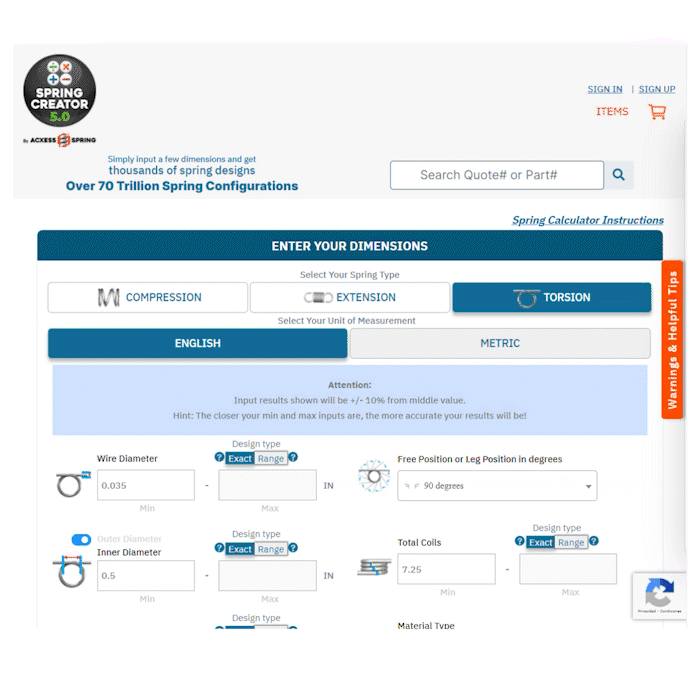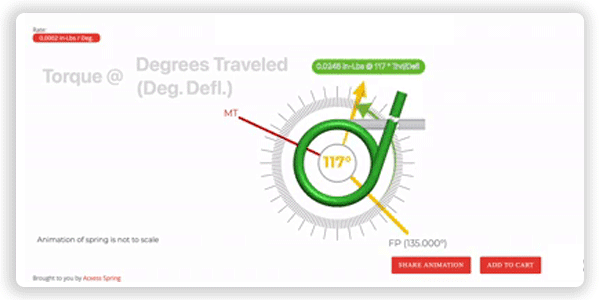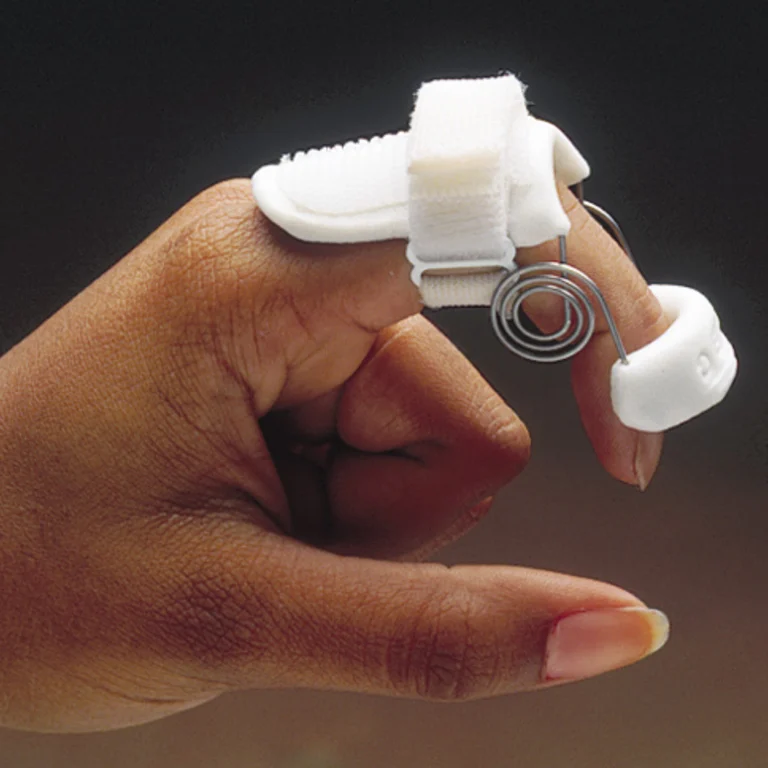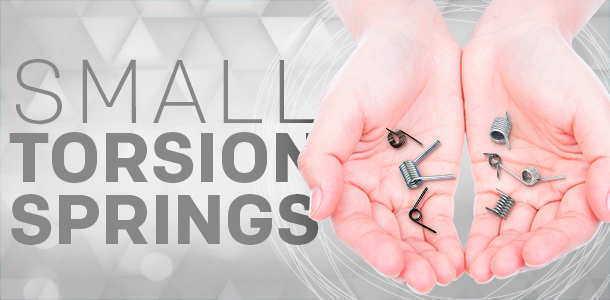Torsion Springs: Enhancing Performance in Medical Instruments
Torsion Springs: Enhancing Performance in Medical Instruments
Torsion springs, with their ability to store and release angular energy, have become indispensable components in the medical field, particularly in enhancing the performance and reliability of various medical instruments. From surgical tools to diagnostic equipment, the precise application of torsion springs significantly improves device functionality and patient outcomes. This comprehensive exploration delves into the unique design challenges, showcases innovative case studies and highlights the crucial role of advanced tools like Acxess Spring's Spring Creator 5.0 and Online Spring Force Tester in driving the evolution of medical torsion springs.
Design Challenges in Torsion Spring Development
Precision and Consistency in Force Application
A paramount challenge in designing torque springs for medical instruments is achieving the precise and consistent torque force required for sensitive applications. These springs must provide a reliable and predictable response to ensure the safety and efficacy of medical procedures. The meticulous calibration of spring force is critical, especially in instruments requiring delicate manipulation, such as endoscopic devices or surgical staplers.
Material Selection for Durability and Biocompatibility
Selecting spring materials that offer both durability and biocompatibility poses another significant challenge. The springs must withstand repeated use and sterilization processes without degrading, while also being non-reactive with human tissue. Advanced alloys like stainless steel and Nitinol are often chosen for their strength, elasticity, and resistance to corrosion, but selecting the appropriate material requires a thorough understanding of the specific medical application and its environmental conditions.


Innovative Solutions Through Advanced Tools
Spring Creator 5.0 for Custom Design
Acxess Spring's Spring Creator 5.0 software emerges as a revolutionary tool in the design of torsion springs for medical instruments. It allows engineers to tailor spring parameters, including wire diameter, coil diameter, and the number of turns, to meet the exact requirements of the medical device. This level of customization is pivotal in overcoming the challenges of precision and consistency, enabling the design of springs that perfectly match the functional demands of medical instruments.

Online Spring Force Tester for Real-Time Validation
Complementing the design capabilities of Spring Creator 5.0, the Online Spring Force Tester offers an invaluable platform for testing and validating the performance of torsion springs. This tool enables real-time visual assessment of torsional spring force under varying degrees of safe travel giving the user the precise inch/lbs of torque at that degree of deflection. This lets the user see all the possible scenarios the torsion spring can give them in terms of safe torque and safe angular distance traveled. This ensures that the springs meet the stringent performance criteria required in medical applications before the spring is manufactured. Such testing is crucial for verifying the reliability and safety of the springs before they are made and integrated into medical devices.


Case Studies and Examples
Surgical Robotics
In the rapidly evolving field of surgical robotics, torsion springs play a crucial role in enhancing the precision and dexterity of robotic arms. A case study involving a leading surgical robotics firm illustrates the importance of torsion springs in providing the necessary tension and torque for robotic instruments. By utilizing Spring Creator 5.0, the firm was able to design custom torsion springs that significantly improved the responsiveness and control of the robotic arms, leading to more precise surgical outcomes.
Diagnostic Equipment
Torsion springs also find critical applications in diagnostic equipment, such as blood analyzers, where they facilitate the precise movement and handling of samples. A notable example includes the development of a blood analyzer device that required torsion springs for its sample loading mechanism. The use of the Online Spring Force Tester allowed the device's manufacturers to ensure that the springs provided the exact force needed to securely hold and release blood samples without compromising their integrity, thereby enhancing the device's accuracy and reliability.
Overcoming Design Challenges
Addressing the design challenges associated with torsion springs in medical instruments requires a combination of advanced spring design engineering techniques, precise material selection, and rigorous testing. Tools like Spring Creator 5.0 and the Online Spring Force Tester are instrumental in this process, offering the capabilities needed to design, prototype, and validate springs online before manufacturing, that meet the high standards of the medical industry.
Material Science and Engineering Innovations
Innovations in spring material science play a significant role in overcoming the challenges of durability and biocompatibility. The exploration of new alloys and surface treatments extends the lifespan of torsion springs and enhances their performance in the demanding medical environment. Ongoing research and collaboration between material scientists and spring manufacturers are vital for discovering materials that offer the best combination of mechanical properties and compatibility with medical applications.
Prototyping and Testing for Excellence
The prototyping and testing phase is critical for ensuring that torsion springs will perform as expected in their intended medical applications. Through rapid prototyping techniques and comprehensive testing protocols, manufacturers can iterate designs quickly, refining the springs to achieve the desired performance. The integration of tools like Spring Creator 5.0 and the Online Spring Force Tester into the development process accelerates this phase, enabling more efficient design cycles and ensuring that the final products meet or exceed medical industry standards.
Precision and Consistency in Force Application
Achieving the required precision and consistency in the application of force by torsion springs in medical instruments represents a formidable engineering challenge. Torsion springs use radial force which is torque per degree of movement, precision is not merely a technical requirement but a clinical necessity, as the performance of these springs directly impacts the functionality of medical devices and, by extension, patient safety and treatment outcomes. In the high-stakes environment of medical procedures, even minor deviations in force application can lead to significant consequences, ranging from device malfunction to compromised surgical precision.
The complexity of this challenge is further compounded by the diverse range of medical instruments that utilize torsion springs, each with its own set of specifications and operational environments. For example, a torsion spring used in a laparoscopic surgical tool requires not only a different force profile compared to one used in an orthodontic device but also needs to maintain its cycles of spring life after repeated use and sterilization cycles. This necessitates an engineering approach that combines advanced spring materials science, precise mechanical spring design, and rigorous online spring force testing protocols.
To address these challenges, manufacturers often turn to sophisticated simulation and modeling tools that can predict how torsion springs will behave under various conditions. Acxess Spring's Spring Creator 5.0, for instance, allows designers to input specific parameters—such as wire diameter, outer diameter, total coils and leg length—to simulate the spring's performance, including its maximum torque and maximum deflection characteristics. This predictive capability is invaluable for refining spring designs before physical prototypes are manufactured, saving time and resources in the development process.
Moreover, achieving consistency in spring force application also hinges on the ability to produce springs with extremely tight tolerances. This level of manufacturing precision requires state-of-the-art fabrication technologies and quality control systems that can detect and correct the slightest deviations from the design specifications. It is here that the integration of real-time testing becomes critical. The Online Spring Force Tester, for example, enables manufacturers to verify the torque force characteristics of each torsion spring design ensuring that every component meets the rigorous standards required for medical applications.
This focus on precision and consistency underscores the meticulous nature of torsion spring design and manufacturing in the medical sector. By leveraging advanced design software and testing equipment, engineers and manufacturers can overcome the inherent challenges of this task, resulting in medical instruments that are both reliable and effective.




Conclusion
The application of torsion springs in medical instruments exemplifies the intersection of precision engineering and innovative design, highlighting their critical role in advancing medical technology. The challenges of designing these springs are met with cutting-edge tools and methodologies, pushing the boundaries of what is possible in medical device development. Acxess Spring's Spring Creator 5.0 and Online Spring Force Tester stand at the forefront of this innovation, providing the necessary resources to design, test, and refine torsion springs that enhance the performance and reliability of medical instruments. As medical technology continues to evolve, the collaboration between engineers, designers, and medical professionals will remain essential in creating devices that improve patient care and outcomes.





